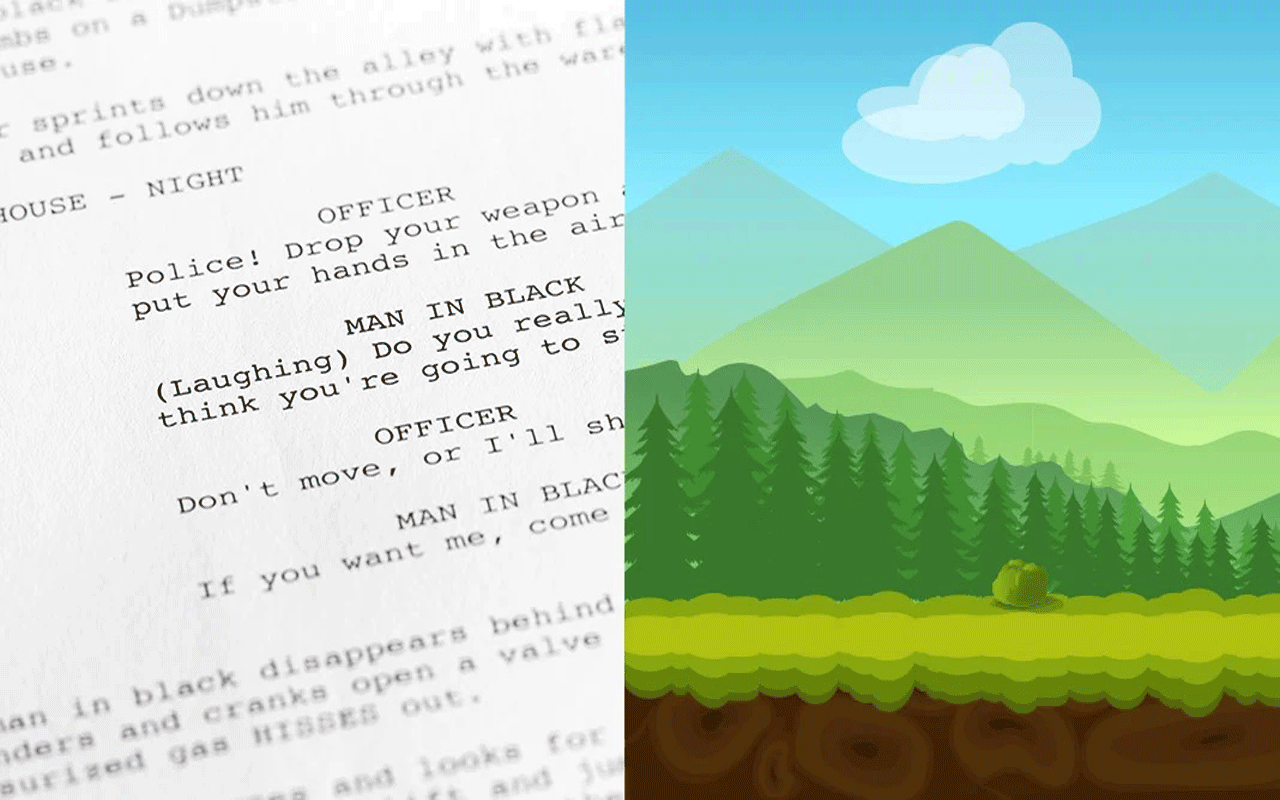To write an outstanding animation script, focus on creating a compelling story with well-developed characters and engaging dialogue. Finally realizing the value of online video, your boss has given you the go-ahead to prepare an animated video for your website. Great! Additionally, you have found a fantastic animated video creation tool for your explainer video. Create a solid script for the animated video before continuing to use the mouse.
You might be thinking of an instructional, educational, promotional, or informative animated video, among other genres. A poor script is complicated to make look good on video. There is a good chance that your animated video will succeed if your script is strong; so this blog is here for you.

Need Animation Services?
Visit our Animation Service page to see how we can help bring your ideas to life!
What Is an Animation Script?
According to the dictionaries, A Script is nothing but “The written text of a play.” In other words, What is finally seen and heard is written on the page. This position for the screenplay format is referred to as script writing (or screenwriting). Writing a script entails capturing the characters’ facial expressions, actions, and language in a screenplay format. Writing a novel, a poem, or an essay is a completely different process from writing a script. Specific formatting techniques are necessary in order to communicate effectively on the screen.
The story is visually expressed using the screenplay format. Scriptwriters or screenwriters write for film, animation, video games, and nowadays even online web series. In fact, it is advisable to invest half of your time crafting an engaging script if you are particularly fussy about the final product and have decided to devote a significant amount of effort to create the animated video. Are you going to create your own animation video script? So you should be aware of different points brought about in this blog.

Become an Animator First!
It’s an unavoidable fact that trying to sell an animation screenplay on spec—writing it with the hope of selling it to someone—can be harder than trying to sell a spec script for a live-action movie. Typically, an animation company creates its own animated works. And animators typically create those projects. The medium of an animator is animation. There’s no getting around that.
Therefore, think about trying to become an animator yourself before beginning your career as a writer for animation. The simplest and most straightforward entry point into writing for animation is that.
You can seek a degree in computer graphics or animation. Disney provides internship options for college students, as well as entry-level growth chances for recent graduates and others who are new to the animation profession. There are also a ton of other opportunities available online.
But fear not—writing for animation has also been successful for non-animators if they know the way through producing 3D animation pipeline.

Animated Videos’ Script Writing
There is no better way to impart specific knowledge, train staff, or publicize your company than through animated video, which is a great medium for selling the message. When a video doesn’t seem staged, it will become authentic. Writing a script for an animation video won’t be possible using the writing skills we learned in college.
It must therefore be absolutely flawless in every way. Every detail and every line of a creative script will refer to the main theme. Your approach should be exactly in a way to present your core message to your audience successfully. Even when your script is just for three or five minutes of animated video. Spend hours, or if possible, days, writing, rewriting, and editing the script until it is flawless. When composing an animated video script, keep the following in mind:
Forget your strengths and concentrate on what the customer wants
- Think about the length and keep it brief
- Try something new and astonish your audience
- Communicate clearly and attract attention
- Connect emotionally
- Tell tales
- Engage in dialogue
- Streamline your main point.
- Personalize it, add humor, and tightly wrap it up
These are just some key points mentioned very briefly in order to write an engaging script. We will discuss more points in detail. The 3 main elements of a script are:
- Location
- Action
- Dialogue
You will for sure need a storyboard through the process. Check out making a storyboard in 6 steps.

Why Should Your Script be Animated?
Too many screenwriters have submitted their work to animation studios without having it in mind to write an animated story. The marketing of your screenplay should rely on something other than animation as a backup or secondary strategy.
But perhaps you should think about writing for animation. You should investigate animation’s benefits that animation can have for your screenplays and stories. The following are the top animation genre choices:
- Science Fiction Fantasy
- Book adaptations for kids
- Adaptations of comics
Even in the age of CGI, animation has the ability to bring these kinds of stories to life in a manner that live-action cannot. Creative and stylistic sights and imagery that wouldn’t translate well to live-action can come to life in this medium. And some that simply couldn’t be done in a live-action production. But there must be a justification. Your story must have a compelling argument for why it would work well as animation. Your script can’t only use animation as a marketing tool. You should decide what type of storyboard to use to make the most out of it.
The ability to accurately represent the storyline and plot occurs for the first time while writing the script for a 3D animation. Writing a script for a 3D animation is a repetitious process that may require several modifications. The hardest part of the process is getting ideas down on paper.
However, early screenplay development aids 3D animation studios in the following areas:
- Keep everyone in agreement
- Fill in any plot flaws that may exist
- Character development in more depth
- Fix a sluggish flow of events
- Improved storyboarding

What Is a Good Script?
An outstanding animation script connects a video with viewers in the simplest, most natural, and direct manner possible. The best writers can therefore produce a script that originates in the mind. Here are four essential qualities of a strong script.

Easy to Understand Language
An excellent script can be written with basic English skills. An animation script’s goal is to make explainer videos as simple to comprehend as feasible. We’re not here to make learning difficult for students by using complicated dictionary terms.
If you can express academic knowledge in the learners’ vernacular, you will succeed. Simplify your terminology so that everyone, including those without prior knowledge of the subject, can understand the information.
Short Sentences
Keeping the content concise and using short, snappy words will help your students acquire the material fast. A snappy sentence can have no more than 20 words. If a sentence contains more than 20 words, attempt to divide it into smaller sentences. This will make the sentences easier to read. You don’t need to include complex sentence structures or big paragraphs because this isn’t an IELTS test or a school writing assignment. So try to bring your ideas to life by using short sentences. Animation ideas have the main role in motivating and assisting in bringing your vision to life.
Conversational Nature
As we’ve previously mentioned, natural writing, such as that which sounds like you’re speaking, works best for educational animation. Create a conversational tone in your writing by setting it. You may quickly create a realistic conversational script by writing as though you are speaking with your readers and incorporating your speech into your sentences.

Moderate Length
For animated videos, the length of the screenplay is equally important because it influences viewer engagement. The unfortunate reality is that the average human attention span is only 8.25 seconds. Keep your script brief if you want viewers to watch your animated film all the way through. An animated video should be 90 seconds long, which is equivalent to 200–250 words in a script.
How to Write an Awesome Animation Script?
Here are 5 key points about writing a flawless animation script, which are general rules, as follows:

Start with a Brief
Writing a script that directs the general course of your animation video requires several crucial steps, including briefing. Why should you start it off? Because of a short outline of the video’s main messages, primary audience, animation style, and learning objectives.
You must ask yourself a number of questions when drafting a brief to make sure that you are crystal clear on the desired learning outcomes. Make a list of questions and thoughtfully respond to each one to identify your main points. Then, as if you were in a real class, write down what you need to say. Your script will become conversational and fluid as a result.
Tone of Writing
One of the most crucial aspects of your animation script is the tone. As it stands, the sound in an animated video makes your course more exciting and engaging for students. The writers should always attempt to inject a small amount of comedy into the video when the subject being covered is dry in order to make it more entertaining.
An educational animated video must, however, maintain its teaching intent while also being entertaining. Animation is utilized to make entertainment that is enjoyable and not annoying. On the other side, the style of your voice-over and the tone of your video are related. Make sure the voice-over reflects your brand voice and your screenplay by taking this into consideration.
Story Telling
Human brains are always drawn to stories. Telling a tale through educational animation can turn academic tedium into excitement. Writing a screenplay using the scenario-based learning approach is the simplest way to describe storytelling. These are problem-solution scenarios with realistic material and relevant narratives.
A compelling tale with a strong message can captivate students’ interest, evoke feelings, and enhance learning outcomes. Additionally, it encourages students to participate actively in your course by sharing your video or attending additional classes on a regular basis.
Don’t Forget About the Call to Action!
The Call-To-Action tells your audience exactly what they should do after watching your course. Great educational animation can’t be efficient if it lacks a Call-To-Action (CTA). Your viewers don’t know what to do next, and you lose a chance to attract your learners to another course. Adding a CTA isn’t a hard task. At the end of your video, leave the screen for a few extra seconds and put a CTA there. A CTA can be whatever you want: subscribe action, visit our website or just an introduction to your new course. The inner machinations of writing for animation is an enigma to most, though this video will tell you tips not to forget.
Review Session
Congratulations if you’ve finished writing a script! You did an excellent job, congrats! But it doesn’t end there. You still need to go back and read the entire script. By revising, you’ll be able to cut out everything that is extraneous or distracting from the point of the videos.
To modify, solicit feedback from your coworkers or pose to yourself some probing questions like these:
- Is it simple to read your script?
- Is it conversational and natural?
- The sentences; are they concise and clear?
- Will it convey the proper message?
- Is the story it tells relatable?
- The CTA—is it a logical connection?
Looking For a Scriptwriter?
Find an excellent 3D animation production company that develops story ideas and presents them as scripts. Whether it’s generating ideas, dealing with storyboards, or paving the way through the whole process of scriptwriting and creating your animation, our professional team is beside you.
Final Words
The story’s formal, textual, and literary form is represented by the script. Almost all the factors of writing an appealing script were explained in this blog. These are particular tips that you should use to become an awesome animation scriptwriter. Take the time necessary to do it, get feedback from your co-workers, and make sure it’s engaging and easy to understand. And don’t forget to follow your learning objectives in order to produce effective educational animations.









